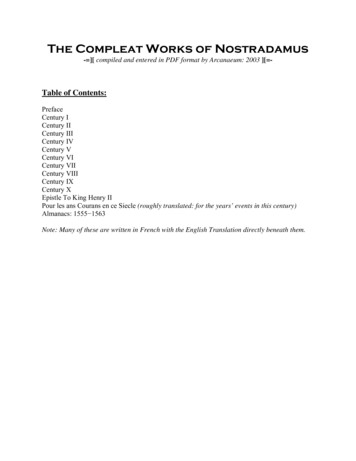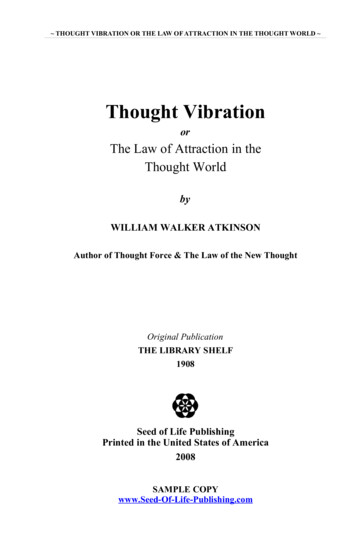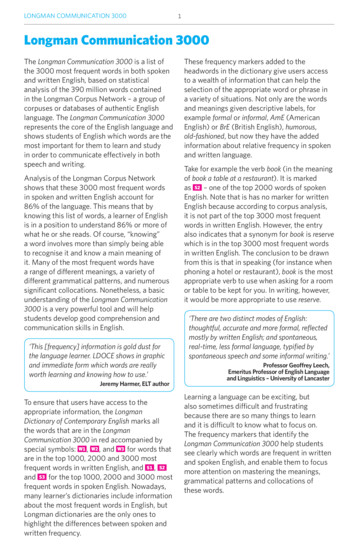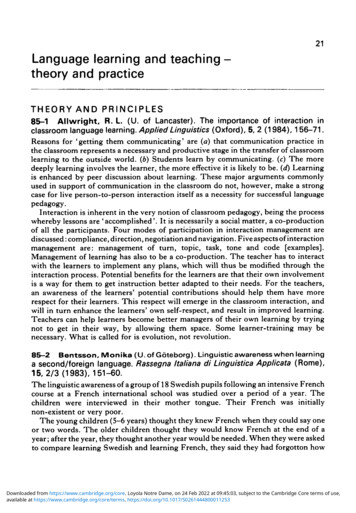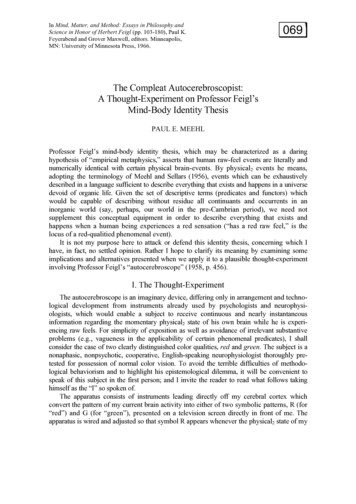
Transcription
In Mind, Matter, and Method: Essays in Philosophy andScience in Honor of Herbert Feigl (pp. 103-180), Paul K.Feyerabend and Grover Maxwell, editors. Minneapolis,MN: University of Minnesota Press, 1966.0691The Compleat Autocerebroscopist:A Thought-Experiment on Professor Feigl’sMind-Body Identity ThesisPAUL E. MEEHLProfessor Feigl’s mind-body identity thesis, which may be characterized as a daringhypothesis of “empirical metaphysics,” asserts that human raw-feel events are literally andnumerically identical with certain physical brain-events. By physical2 events he means,adopting the terminology of Meehl and Sellars (1956), events which can be exhaustivelydescribed in a language sufficient to describe everything that exists and happens in a universedevoid of organic life. Given the set of descriptive terms (predicates and functors) whichwould be capable of describing without residue all continuants and occurrents in aninorganic world (say, perhaps, our world in the pre-Cambrian period), we need notsupplement this conceptual equipment in order to describe everything that exists andhappens when a human being experiences a red sensation (“has a red raw feel,” is thelocus of a red-qualitied phenomenal event).It is not my purpose here to attack or defend this identity thesis, concerning which Ihave, in fact, no settled opinion. Rather I hope to clarify its meaning by examining someimplications and alternatives presented when we apply it to a plausible thought-experimentinvolving Professor Feigl’s “autocerebroscope” (1958, p. 456).I. The Thought-ExperimentThe autocerebroscope is an imaginary device, differing only in arrangement and technological development from instruments already used by psychologists and neurophysiologists, which would enable a subject to receive continuous and nearly instantaneousinformation regarding the momentary physical2 state of his own brain while he is experiencing raw feels. For simplicity of exposition as well as avoidance of irrelevant substantiveproblems (e.g., vagueness in the applicability of certain phenomenal predicates), I shallconsider the case of two clearly distinguished color qualities, red and green. The subject is anonaphasic, nonpsychotic, cooperative, English-speaking neurophysiologist thoroughly pretested for possession of normal color vision. To avoid the terrible difficulties of methodological behaviorism and to highlight his epistemological dilemma, it will be convenient tospeak of this subject in the first person; and I invite the reader to read what follows takinghimself as the “I” so spoken of.The apparatus consists of instruments leading directly off my cerebral cortex whichconvert the pattern of my current brain activity into either of two symbolic patterns, R (for“red”) and G (for “green”), presented on a television screen directly in front of me. Theapparatus is wired and adjusted so that symbol R appears whenever the physical2 state of my
2visual-perceptual cortical area is that known (by Utopian neurophysiology) (a) to be producedby retinal inputs of red light waves in persons with normal color vision, and (b) to ordinarilyproduce a tokening of “red” in cooperative English-speaking subjects. This brain-state wedesignate by the lower-case italic letter r; also by “Φr.”The same conditions hold, mutatis mutandis, for the television symbol G in relation tothe green brain-state ( g). It is important to be clear that the apparatus’s symbolpresentation depends solely upon the visual-cortical state, and is not wired so as to bedirectly influenced by other events. If, while the visual cortex is in state r, the cerebraltokening mechanism should happen (for whatever reason) to token “green,” or the lightwaves entering the eye should be in the physical2-green spectral region, these events arewithout causal influence upon the television symbol presentation.However, the television system of the apparatus is also (and independently) arranged soas to vary the hue of whatever symbol is being presented, and the symbol (regardless ofwhether it is R or G in type) is sometimes colored red and sometimes green, this colorationpersisting from, say, 5 to 20 seconds before it changes, and the variable interval lengthsbeing randomly determined.Under these conditions it is psychologically possible for me as subject to attendsimultaneously to two rather simple aspects of my momentary visual experience, i.e., theshape and the hue of the presented symbol. By this arrangement we avoid the old stomachache about when introspection is “really” short-term retrospection, and at least minimize thetouchy problem of how many things a subject can attend to simultaneously.What instructions are given to me as subject in this Utopian experiment? We first agreethat I am to use the words “red” and “green” to designate experienced color qualities. Forsimplicity and speed of reporting, the single hue-quality word “red” (or “green”) will beconventionally taken as elliptical for “I am now experiencing a visual raw feel of red (orgreen) hue quality,” respectively. As a neurophysiologist I am, of course, aware of the factthat I, and other normal English-speakers, have historically acquired our shared colorlanguage by a rather complicated process of social learning. Since the thing-predicate “red”is employed ambiguously in vulgar speech, referring indiscriminately to (a) surface physicochemical properties of external objects, (b) the distribution of light waves such objects aredisposed to reflect in “standard” illumination conditions, and (c) the raw-feel qualitynormally produced in persons exposed to such stimulation, a terminological stipulation isrequired for more exacting experimental purposes. In common life, the ambiguity is notoften a source of malcommunication because either the three conditions are simultaneouslyrealized or the context makes the speaker’s intention clear. In special cases, as when a personasserts “That’s red” in a red-illuminated darkroom, it may be necessary to question him as tohis intention, and decide for the truth or falsity of his claim accordingly. In the presentcontext, I as subject am instructed to employ the color predicate “red” in its phenomenalusage, i.e., as a predicate descriptive of the experienced raw-feel hue-quality.If all goes as expected, I find myself tokening “red” as descriptive of my experiencedcolor whenever the television symbol has the shape R, and tokening “green” when itpresents the symbol G. In speaking the phenomenal language, it seems clearly appropriateto token “red” (labeling the experienced hue) and “R” (labeling the experienced sign-shape)quasi-simultaneously. If necessary, I can be instructed to report the experienced hue orallyand the experienced sign-shape by depressing one of two keys. In speaking the physicalthing-language, with the intention of denoting the external physical2 properties of the distal
3stimulus, I find myself willing (on the basis of my raw feel but with reference to the objectivetelevision screen) to allege that the screen is displaying a red-colored letter R, or a greencolored letter G, as the case may be. The received laws of psychophysiology seem to beinstantiated, and I am so far content with the status of my mental health as well as thesoundness of Utopian neurophysiology. Both my brain and the autocerebroscope appear tobe functioning satisfactorily.But now a frightening aberration unexpectedly occurs. One day, after an otherwise“normal” run has gone on for several minutes, I find that I am experiencing green when the(apparently green-hued) symbol is R-shaped. I announce this disparity to my researchassistant, who takes a long look himself and embarrassedly informs me that the R symbollooks appropriately red to him. Perhaps, he suggests timidly, I am mis-speaking myself? I takestock carefully, and remain very sure that I am at the moment experiencing a green-huedphenomenal event. I find no difficulty articulating the word “red,” and by shutting my eyes Ifind that I am (being an excellent color visualizer) able voluntarily to call up a pretty goodred-hued image. But upon opening my eyes, I continue to “feel certain” that the raw-feelpredicate “green” is the correct description of what I see when looking at the screen. I am notin the state of a severe compulsive patient who feels involuntarily impelled to utter the“wrong word,” nor of the aphasic who hears himself speak a word he knows isn’t what hehelplessly wants to say. The word “green” seems perfectly appropriate to me, given theinstructions to describe my momentary raw-feel experience. The concurrent “inappropriateness” feeling arises not from doubt or vagueness about the phenomenal quality, but solelyfrom my scientific knowledge about the causal network in which I and my experiences arepresumably embedded. The autocerebroscope informs me that my visual cortex is in ther-state, which it should be because the television screen is (according to my assistant)emitting red light. I can, of course, dispense with the assistant’s report and substitute othermultiple observers, plus additional physical apparatus, to confirm that my objective retinalinput is physically red light.Suppose now that I carry out detailed and thorough checking and testing of the entireapparatus, as well as gathering the testimony of multiple observers. And suppose that all ofthe obtainable evidence continues to indicate, via numerous tightly knit nomologicalrelationships and over-determined particulars, that there do occur unpredictable butrepeated occasions in which my visual cortex is in physical2 state r, that state being causallydetermined by objective inputs of physical2-red light from the physical2-red-colored screen,and yet I am, on those occasions, momentarily certain that I am experiencing phenomenalgreen. Over an extended series of trials, this happens in about 10 per cent of my phenomenalreports. A critical question here is, of course, what precisely this “momentary certainty”amounts to (e.g., is it more than the fact of psychological indubitability?). We shall set thisquestion aside for now, because we can approach it more fruitfully after examining somefurther ramifications of the autocerebroscopic thought-experiment in its causal-scientificaspect. Proceeding still at a “common-sense” level (Utopian-science common sense, that is),how do I meta-talk about my situation as aberrant autocerebroscopic subject? I want totoken “I experience green” in obedience to the instructions, and I do not need to infer thisraw-feel proposition from any other propositions. If my colleagues ask me why I persist insaying “I experience green,” I can only remind them of their instructions, which require meto describe my phenomenal events, rather than to make causal claims about the apparatusor the physical2 state of my visual cortex. If asked whether I consider “I experience green”
4to be incorrigible, I reply that all empirical propositions are corrigible—perhaps adding thatif I keep my sanity I may end up being forced to correct “I experience green” in particular!However, I confess that I can’t cook up a genuine doubt that I am now experiencing green.This means that while I sincerely admit corrigibility, I am at the moment unable “seriouslyto entertain the notion” that the future evidence will, in fact, turn out that way. I know ingeneral what such evidence would consist of, and I firmly believe that it would be rational ofme, in the face of such evidence, to conclude that my presently tokened “I experiencegreen” was false. I hope that I am a rational enough man so that I would at such time findit psychologically possible to abandon the proposition. And if I were not to turn out in theevent to be that rational, still I am prepared now to say that such a development wouldprove me to be less rational than I had supposed. Nevertheless, I am not now psychologicallyable to make myself seriously doubt that I am experiencing green, and hence I don’tseriously entertain the notion that the situation will arise. In short, I remain confident that, ifwe keep looking, we will succeed in locating the “bug” in the autocerebroscope which, Ihypothesize, is the true explanation of these crazy events.Is there any dishonesty, unreasonableness, or inconsistency in this combination of assertions and expectations? If I am a Utopian identity theorist, I consider it physical2-impossibleto “experience a green raw feel” while my brain is in state r. To assert such a thing would belike saying “This soup, while very hot, consists of motionless molecules.” Such a statement isframe-analytically1 false within the nomological network of physics; one who holds thekinetic theory of heat might go so far as to call such a statement meaningless.Suppose that exhaustive tests of all conceivable kinds fail to reveal any defect in theautocerebroscope’s structure, function, or brain-attachments. At some point I become convinced that there are times when my visual cortex is in state r but I am simultaneouslytokening “I see green,” and that this (inner) tokening “seems clearly descriptive of my rawfeel.” What are the possibilities open to me for making causal sense of such a bizarre stateof affairs?We begin with the received doctrine of Utopian neurophysiology, which accepts theidentity thesis and which further identifies a particular brain region (or, better, system ofrelated cell-assemblies) as the physical2 locus of events whose occurrence constitutes avisual raw-feel event. (I believe that Professor Feigl is clearly committed, although he is notvery happy about it, to saying that a raw-feel event is literally, in a physical2 sense, in thehead—since otherwise he contradicts Leibniz’s Principle. See Section IV below.)1Throughout this paper I use the expression “frame-analytic” to mean, roughly, true by “theoretical definition”; which latter phrase in turn means, roughly, stipulation of meaning (explicit orimplicit) in terms of other theoretical constructs which are themselves “defined implicitly” by theaccepted nomological network. While such frame-analytic truths therefore rest in one sense uponconventions, these conventions are far from “arbitrary,” but are adopted on the basis of ourtheoretical knowledge—our current best available notion of “how the world is.” The deeper issuesraised here (e.g., status of so-called conventions in empirical science, clarity and defensibility ofthe traditional analytic-synthetic distinction) are beyond the scope of this paper and of my competence. Frame-analyticity is closely related to truth by P-rules, by meaning-postulates or A-rules, andthe like. See, for example, Carnap (1950, 1952), Maxwell (1961), Sellars (1948, 1953), Feyerabend(1962). I do presuppose in employing the phrase “frame-analytic” that whatever may be the finalresolution of this cluster of technical philosophical problems, some important distinction will bepreserved between the kinds of analyticity involved in “bachelor unmarried male” and “temperature mean kinetic energy of molecules.”
5Presumably Utopian psychophysiology asserts—or, better, for one who accepts its nomological network, “implicitly defines”—a one-many relationship between raw-feel predicatesand physical2 brain-state functors. A set of structural assertions about neurons (numbers,positions, and synaptic connections of a very complex kind) identifies the cerebral systemwhich is the locus of visual raw-feel events; thus, visual raw-feel events cannot occur in thetransverse gyrus of Heschl (auditory projection area), but they can occur in the calcarinecortex (or Brodmann’s area 18?). We designate by “V” the cortical region or functional subsystem which is the locus of visual raw-feel events. Given an appropriately structured cerebralsubsystem, its momentary state is exhaustively characterized by a set of physical2 functors.These might be simple (e.g., strength of electromagnetic and electrostatic fields), or, morelikely, complex (e.g., second time-derivative of a proportion of instantaneously activatedsynaptic knobs on cells of type X in cell-assemblies of structure S). The received neurophysiological network asserts that a necessary and sufficient condition for experiencing a red rawfeel (or, the theoretical definition, within this causal framework, of brain-state r) is that acerebral system of type S must be in a state described by a complex conjunction of physical2functor inequalities:P: One-place predicate designating the phenomenal quality,L: Two-place predicate locating a brain-event in the brain of a person,Ψ: Two-place predicate designating the internal Erlebnis-relation, “.experiencesphenomenal event.,”Φ: One-place predicate designating the complex physical2 property which a brain-eventhas when its physical2 functors satisfy certain inequalities (the relation of raw feel tobrain-state being, presumably, one-many),x: Variable ranging over persons,y: Variable ranging over phenomenal events,z: Variable ranging over physical2 brain-events.Reference to time is omitted, taken as quasi-simultaneous.Then the empirical “psychophysical correlation-laws” are:(x,y) Ψ (x,y) i P (y) (Ε!z) L (z,x) i Φ (z)(x,z) L (z,x) i Φ (z) (Ε!y) Ψ (x,y) i P (y).The Feigl theory consists of conjoining to each of these correlation-laws the identityassertion(y z).But we have so far not done justice to the advanced development of Utopian neurophysiology. Although our thought-experiment began by wiring and attaching the autocerebroscope only to provide information about events occurring in the cerebral locus of visualraw-feel events, Utopian knowledge of brain function includes much besides this. For the“normally functioning brain,” we also possess scientific understanding of the causalrelations obtaining in other cerebral systems, including the tokening mechanism. This meansthat certain problems of methodological behaviorism, and certain philosophical difficultiesarising from reliance upon vulgar speech, have been “solved”—insofar as empirical knowledge ever solves problems. The differences between raw-feel utterances which are “correct,”“false because of lying,” “false because of mis-speaking,” “false because of being hypnotized,” “false because of aphasia,” “false because of slovenly language training,” “false
6because of having previously misread an English-German dictionary,” etc., are formulable byreference to where in the intracerebral causal chain the tokening process and its controlshave gone awry. Presumably Utopian neurophysiology will have isolated a cerebral system T( the tokening system) which is the physical locus of events tr, tg, etc., these events being theinner tokenings of raw-feel predicates “red,” “green,” etc. These tokening events are the immediate causal descendants of raw-feel events in the visual system V; and they are theimmediate causal ancestors of events in intermediate instrumental systems which arouse,trigger, and monitor subsequent motor-control systems that give rise to families of overt actsof the reporting kind (vocalizing “red” or pressing a red-colored lever). Detailed experimentaland clinical analysis will have made clear which system does which, and it will be preciselyknown how, for example, a red-qualitied visual raw feel gives rise to vocalizations of “red,”“rot,” or “rouge” in a trilingual subject, depending upon the instructions given him or hisperception of the momentary social context. Obviously none of the three cell-assemblysystems on the motoric side which control utterances of “red,” “rot,” or “rouge” would beconsidered as the primary tokening mechanism, especially for purposes of philosophicaldiscussion. We need not here decide upon the precise conditions necessary for identifying theprimary tokening system T, since for our purposes it will suffice to place certain conditionsupon it. It must at least undergo states which are physical2-distinguishable, and these distinguishable states must be correlated (in a normal person) on the one side with the raw-feelevents, and on the other with “appropriate” states in the first-order motoric system. That is,T is the locus of events tr and tg which are the causal descendants of raw-feel states r and grespectively; and the states tr and tg are the causal ancestors of events mr and mg respectively, these latter being events in the “English-set motor-control system” which—ceterisparibus—give rise to differentiated chains continuing through the motor area to effectororgan events (vocalizations of “red” or “green”). In this scheme, the tokening mechanism Tis the physical2 locus of tokening propositions ( “making judgments”), whereas the eventsm are tokenings of sentences. For present purposes, a subject tokens “red” when the primarytokening system T is the locus of physical2-event tr regardless of whether he utters, or “tendsto utter” (by covert laryngeal twitches) the English word “red” or the French word “rouge,”or even if the process is for some reason stopped short of affecting any part of the instrumental reporting mechanism.2 What we require, in short, is that system T must be the locusof physical2-differentiable events tr and tg with input and output conditions appropriatelycorrelated. It will not suffice, for example, to find a system which is activated whenever avisual raw-feel event recurs, and whose correlated report is one of mere “familiarity” (e.g., “Ihave experienced this color before”). When the hue of a raw feel is our subject matter, theprimary tokening mechanism must be the locus of distinguishable symbolic events that arehue-correlated.The nomologicals of Utopian neurophysiology not only assert causal dependenciesbetween raw-feel events in V and tokenings in T (e.g., r »» tr, g »» tg) but they also2This formulation does not, I would think, prejudice the philosophical issues, and is simpler to talkabout for present purposes. If no such mediating judgmental tokening occurs, then for the “propositional,” primary tokening event t we would presumably have to substitute some sort of conjuncttion of (1) an “English-set” superordinate event, elicited by one’s perception of the audience asbeing English-speaking, and (2) the first link in an English-verbalizing event-sequence, which linkis activated (instead of French or German) because of the superordinate “English-set” regnancy.These are presently unsettled issues in psycholinguistics.
7permit these nomologicals to be derived as theorems. That is, the structural statementsabout how the brain is organized genetically, when combined with more fundamental lawsof neurochemistry and physics, suffice to explain neurophysiological laws of such intermediatemolarity as (g »» tg). Gross (and merely stochastic) regularities at the level of molar behavior (e.g., “Normal people almost always report ‘red’ as an afterimage of green stimulusinputs”) are shown to be physical2-deducible from a combination of neurophysiological lawsof intermediate level with detailed narration of social learning histories. These intermediatelevel laws are themselves deducible from structural laws about how the human brain iswired, together with microlaws expressed in terms of microanatomy, biochemistry, andphysics. The stochastic character of the more molar laws is itself explained within the system,and provides a causal account of the vagueness intrinsic to most ordinary phenomenalpredicates.If Utopian neurophysiology embodies Feigl’s identity thesis, it does so on the basis ofmuch more evidence than that available to Feigl in the mid-1960s. Why has Utopianneurophysiology augmented its psychophysical correlation-law with the conjoined identitystatement? Why has it not preferred a psychophysical interactionist nomological of formg »» Ψg »» tg which speaks of a raw-feel event Ψg that is not physical2 but onlyphysical1 (belonging in the space-time network)?I submit that the reason for this scientific decision would not be different from any otheroption in which the scientist dispenses with a supernumerary event or entity in concoctingand corroborating his causal picture of the world. He does not feel under any obligation to“rule out” alleged events Ψg, but only to show that they are causally dispensable. His situation is like that of the geneticist, who began with Mendelian “factors” (evidenced on themolar side by certain phenotypic breeding statistics) and ultimately identifies them withgenes (i.e., with chemical packets found in specific chromosomal loci). We do not ask thegeneticist to “prove that there aren’t factors ‘associated with’ genes,” once he has shownthat the causal role played by factors in explaining the phenotypic statistics is indistinguishable from the causal role assigned to genes in physiological genetics.I am not here attempting to beg the crucial philosophical question, whether it can evenmake sense to identify a simple phenomenal predicate’s intension with the meaning of acomplex physical expression. Our Utopian neurophysiologist may be guilty of a philosophical mistake, through not seeing that the mind-body problem involves semantic (or epistemological?) issues which are unique. This question we shall examine below. My point here isthat if it is philosophically admissible to assert the identity thesis, if it can be consideredmeaningful at all, then the empirical grounds for embodying it in the network will be of theusual scientific kind. The scientific aim is to concoct a nomological network in which allevents find their place; if the causal antecedents and consequences of Ψg are indistinguishable from those of g, we have merely two notations for one and the same scientific concept.The abstract possibility that Ψg should be retained to designate a kind of event distinctfrom g which might conceivably exist “alongside it,” but lacking any causal efficacy,would not impress any scientist. He would properly point out that when Lactobacillusbulgaricus was shown to be the causative agent behind the curdling of milk, the lowliestHausfrau ceased to speak of brownies; that geneticists do not hypothesize factors “parallelwith” or “mediating the action of” genes; and that caloric has been dropped from physicalvocabulary since the kinetic theory of heat. There “could still be” such things as brownies,factors, and caloric; received science may be in error, and one cannot refute an existential
8proposition. But when the previously assigned causal role of a hypothesized entity is found tobe either unnecessary or identical with a more fully known entity, the separate existence ofthe old one is no longer seriously maintained.The “possibility” of a parallel event lacking causal efficacy has a special interest in theraw-feel case, which it may be profitable to examine here. It is sometimes argued that psychophysical interactionism, psychophysical parallelism, and epiphenomenalism are meaninglesspseudotheories because they could not in principle be distinguished. In the diagram werepresent causal connection by the arrow »» , distinguishable mental events by Ψi,distinguishable physical2 events by Φi, and time relationships by the correlated subscripts i.The issue of simultaneity versus precedence in causation is set aside for present purposes.Critics of these distinctions point out that while the diagrams make it appear that wedeal with three theories, they achieve this (misleading) effect by arbitrarily droppingselected arrows which represent perfectly good nomologicals. If Φ1 is a necessary andsufficient condition for Φ2 and also for Ψ1, then the conjunction Φ1 Ψ1 is necessary andsufficient for Φ2; and which nomologicals we elect to draw in as “causal arrows” is surelyarbitrary. Hence the three theories have indistinguishable content.In spite of a fairly widespread acceptance of this analysis, I believe it to be mistaken,or at least in need of further justification by invoking an ancillary principle which I see nogood reason to adopt. The usual practice in science, when inquiring as to the existence anddirection of causal arrows, is to carry out the analysis at all levels. When an experimentalseparation of confluent factors is technologically (or even physically) precluded, we do notabandon our attempt to unscramble the skein of causality by distinguishing merelycorrelated from causal relations. The commonest method of doing this is microanalysis,which in advanced sciences is extremely powerful, and often suffices to satisfy any reasonabletheoretical interest. In the biological and social sciences, where much of our evidence(especially in “field” and “clinical” studies) consists of correlations within the material as wefind it, the only reasonable basis for choice may lie in moving our causal analysis to alower level of explanation.In the psychophysical problem, it should not be assumed that the physical2 eventsdesignated by the Φ’s are incapable of further analysis. If we characterize Φ1 and Φ2 byconjunctions of physical2 expressions designating their respective microdetails, so that Φ1 iswritten out as a complex conjunction of physical2 functors (limiting case: elementary physi-
9cal particles, electromagnetic fields), we ask whether the intermediate-level law (Φ1 »» Φ2)is derivable from the fundamental nomologicals (the structure-dependent features of Φ1being now packed into the microconjunction). If (Φ1 »» Φ2) is microderivable, then ourcausal account of Φ2 is complete without the “mental correlate” Ψ1 being required. Thenomological relation between Ψ1 and Φ2 is a universal correlation but not a relation of causaldependence. If we retain Ψ1 in our network, it will have to be for an extrascientific reason,such as a philosophical argument refuting the identity thesis analytically.Having thus distinguished interactionism from the other two, can we tell them apart?Suppose that the phenomenal events themselves have sufficient richness to permit characterizing each of them by, so to speak, crude “phenomenal quasi-functors” (e.g., the colorso
In Mind, Matter, and Method: Essays in Philosophy and Science in Honor of Herbert Feigl (pp. 103-180), Paul K. Feyerabend and Grover Maxwell, editors. Minneapolis, MN: University of Minnesota Press, 1966. 069 1 The Compleat Autocerebroscopist: A Thought-Experiment on Professor Feigl’s

